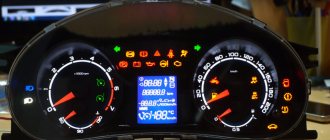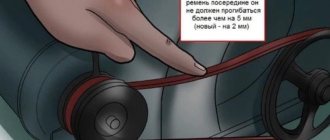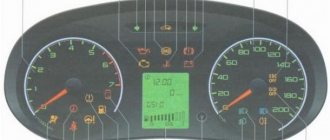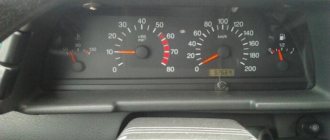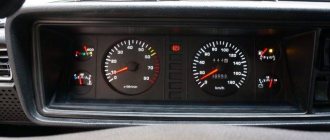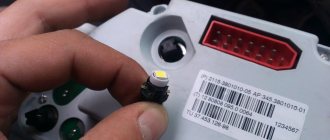As you know, the injection engine has replaced the carburetor engine mainly due to its efficiency, as well as the reduced amount of harmful emissions into the atmosphere. This became possible as a result of flexible adjustment of the operation of the internal combustion engine using the electronic control system of the ECM.
The further development of such control systems has made it possible to provide modern cars with the ability to conduct self-diagnosis, record errors and even decipher them. The decrypted data is then displayed on the on-board computer screen. In this case, the simplest indicator that indicates to the driver that a malfunction has occurred is the check engine lamp or “check”.
Note that the indicated “check” lights up for various reasons. In this article we will talk about why the check light blinks, the engine stalls, or the power unit is unstable in different modes, and such operation is accompanied by a lit internal combustion engine fault indicator.
What is a check engine?
“Check Engine” is translated from English as “Check the engine.” On different cars, on the dashboard there is either such an inscription, or simply “Check”, or an engine icon. On the Priora, it is the yellow icon that lights up, resembling an engine in shape. “Check” lights up in two cases:
- Checking the functionality of the sensors. When you turn on the ignition, all the icons on the dashboard light up, indicating that there is a signal from the ECU and the system is ready to operate. After 2-3 seconds of turning on the ignition, the icon will go out.
- Malfunction of the engine operating system. There are several important aspects. Firstly, the ECU does not receive data about all breakdowns: it cannot technically record any mechanical damage. Secondly, the appearance of this icon may be erroneous. But you shouldn’t trust the opinion “it’s all for nothing” - a problem with the engine can grow like a snowball and cost a pretty penny if you ignore it. Regardless of whether the “check” on the Priora is on or flashing, the problem needs to be solved.
Priora: why the check is blinking or on - the main reasons
The diagnostic connector will help you “talk” to the electronic control unit and find out why the check light is on. Well, before you start diagnosing, check out the list of the most common Priora “errors”:
- Low Oil Level – Low oil levels ultimately lead to increased engine wear. If the oil level turns out to be normal when checked, then it needs to be replaced and the integrity of all Priora components checked. Faulty fuel pump or fuel filter. You can’t always “hear” this, but diagnostics, replacing the filter, and checking the fuel pump will “cure” the breakdown.
- An error in the operation of the exhaust gas system - this is not something to joke about - it is better to start repairs as soon as possible.
- The ignition coil does not produce a spark / the catalytic converter is unstable.
- Wiring problems - high voltage wires can give an erroneous signal to the ECU - "Check" will light up on the dashboard.
- Malfunction of sensors - unfortunately, they very often fail. The “check” lights up due to the fault of the mass air flow sensor (MAF), two oxygen sensors (after the fuel afterburner and in the exhaust manifold), the crankshaft sensor and the camshaft sensor. In frosty weather, the “Check” may light up because three cylinders are turned on first, and then, during normal startup, it does not go away. This is due to the fact that soot particles remain on the contacts - they disappear after a few days.
- False sensor activation due to high humidity
- The engine starts running when cold and the check light comes on.
Engine diagnostics
Why does the Lada Priora engine stall? Before proceeding with the analysis of the mechanical part of the fault, many owners and mechanics recommend conducting computer diagnostics of the car. Maybe you really shouldn’t go into the mechanical part and look for faults there, but just look at what the electronic engine control unit shows in this case.
So, for computer engine diagnostics you will need a vehicle connection cable (OBD II), a laptop or tablet, and the appropriate software.
Having connected and synchronized with the car, we diagnose the condition of the engine, and also analyze the errors that it generated. Based on this information, you can understand whether all sensors are working properly, and whether there are problems in the software.
The next step is to check the engine sensors using a tester. They are diagnosed by ringing the contacts to see if they are working in the on-board network and if there is an impulse that goes to the ECU. So, what sensors need to be checked:
- Coolant temperature sensor.
- Mass air flow sensor.
- Idle speed regulator.
- Knock sensor.
- Crankshaft position sensor.
If any of these meters fails, it must be replaced. After this, it is recommended to reset all errors that were detected in the control unit. The electronic procedure is completed.
How to reset "Check Engine" on Priora
If the check light is on, then there are two solutions to the problem: fix it, or reset it. The engine icon that lights up is evidence that the ECU has received information about some kind of malfunction in the engine and is informing the driver about it. All errors remain in the computer's memory, so in order to get rid of them without repair, they need to be reset or erased. You can reset a check by following these steps:
- Turn off the engine, secure the car, and open the hood;
- Find the fuse box, in the yellow group, remove F1 (30 Amperes) and wait about 20-30 seconds;
- Put the fuse back and close the hood. Start the engine and check if the signal disappears.
The pressing question of why the check light is on in a Priora, but the engine is running normally, periodically interests many owners of this car. On-board computers have been installed in cars for several decades now. The first "Check Engine" warning lights provided information solely on the condition of the carburetor.
Modern sensors, including those on the Priora, inform the driver about irregularities in the fuel system, engine, spark plugs, battery and many other units.
When starting the car engine, under normal conditions, the check light flashes briefly and immediately goes out. If the light comes on while driving and remains active for an extended period, this may indicate certain problems.
Possible reasons
Why the check light on the Priora is on, but the engine is running normally - we will try to find out further. To find the reason for the blinking indicator, it is advisable to contact a service station, where specialists will carry out diagnostics and find out the code and specifics of the problem. In different situations, the indicator may light up due to minor defects in a particular car system.
The main factors for the check to catch fire can be the following options:
- If the sensor lights up only while the Priora is driving, you should pay attention to the oil level. If this indicator is normal, it is advisable to change the oil after first checking the engine for defects and damage (if possible in a specialized center);
- The reason for the blinking of the indicator may be low-quality fuel that floods the spark plugs;
- If the engine runs normally but the check light is on, the problem may be the fuel filter or fuel pump. By replacing the appropriate filter elements, you can get rid of the problem;
- If there is no spark from the ignition coil, the check engine may also be activated;
- Faulty high voltage wires can activate the light bulb. They need to be checked and replaced if necessary.
The car accelerates poorly
There are many reasons for the deterioration of dynamics, the main ones can be defined as follows. 1. Engine malfunction: decreased compression in one or more cylinders, leakage of additional air into the engine intake tract. Coking of the exhaust system or damage to the exhaust gas converter (if the vehicle is equipped with a catalytic converter).
2. Malfunction of the power supply system: clogged injectors and fuel filter, hoses of the fuel supply system. Insufficient fuel pump supply. Use of low quality fuel.
3. Malfunction of the ignition system: failure of the spark plug, breakdown of the high-voltage circuit of the system.
4. Engine management system malfunction: failure of system sensors. If any sensor fails, the electronic control unit switches to working according to a backup program, allowing you to get to a garage or car service center, but at the same time the power and economic characteristics of the engine are reduced.
5. Clutch slippage due to wear or misadjustment.
7. Insufficient air pressure in tires.
8. Vehicle overload. Full diagnostics of the car should be carried out by highly qualified technicians using special diagnostic equipment, so contact a car service center.
You can do the following work yourself
1. Check and adjust tire pressure to normal.
2. Check the operation of the service brake system and parking brake. It is not necessary to remove the wheels for this. Find a flat section of the road and, in dry, windless weather, conduct a test run to determine the vehicle's run-out. The car must be fully fueled, with only the driver in the cabin. Accelerate the car to 50 km/h, level out the speed, then switch off the gear and coast until it comes to a complete stop. Do another run in the opposite direction. The run-out should be about 500 m.
3. Check the operation of the ignition system as described above.
New Lada: How to train the key of a Lada Priora
4. Check clutch operation. The initial check is carried out on a level area free of obstacles. Set the accelerator pedal to a higher idle speed - approximately 1500 rpm. Brake the car with the parking brake. Depress the clutch and engage first gear. Then begin to smoothly release the clutch pedal.
5. Check the serviceability of the engine control system.
Tips and reviews from motorists
Judging by the reviews of Priora owners, we can conclude that the following factors may be the reasons for the activation of the engine control warning light:
- In severe frosts, when starting the engine, only three cylinders may turn on, therefore, the check light comes on. After restarting the engine in normal mode, the light may continue to blink for several days. As experts explain, when jamming, a carbon particle can get on the contact and freeze. The spark disappears until the spark plug is cleaned;
- High humidity can also cause the sensor to activate unexpectedly. Usually, after drying the car, the flashing goes away;
- Electronics failure;
- Low quality gasoline. One of the most common reasons is when, due to carbon deposits, the engine starts to stall, and the checkbox reacts to this by lighting up;
- Fuel tank cap is not tightly closed;
- Untimely replacement of spark plugs.
What to do?
The first sign that it is necessary to diagnose the car engine is the long burning of the check sensor. Considering that the blinking of this assistant may indicate serious problems, you should not ignore this procedure. However, for various reasons, vehicle owners cannot send their cars for inspection or are confident that the engine’s operation is not impaired.
Some drivers advise disconnecting the battery terminals for a few minutes to reset the sensor error. If reconnection does not work and the lamp continues to light, you should contact diagnostics. Do not forget about timely replacement of spark plugs, since the appearance of carbon deposits is the second reason for the continuous burning of the engine operation sensor.
It is worth noting that not only Priora owners complain about this problem. Many drivers, both domestic models and foreign cars, record the activation of the check due to abnormal weather conditions or bad gasoline. At a service station, engine diagnostics will cost about a thousand rubles. Considering that engine overhauls are much more expensive, it makes sense to take the time to check the power unit.
Of course, if after drying the car, replacing oil, spark plugs, gasoline, wires or other surface faults, the indicator does not blink, it means that the problem has been resolved and you can drive without visiting a service station. The main reasons why the check light on a Priora is on and the engine is running normally may indicate minor problems in the ignition elements, fuel or battery. This problem can also occur during severe frosts and after heavy rainfall.
the Lada Priora engine troit?
8 and 16 valves and what to do
Lada Priora
- a favorite among Russian cars, sales of modern vehicles are breaking records. Among the advantages of the Priora, owners note a good engine, which, in comparison with other Lada models, has the best dynamics; the interior is also very comfortable. But it doesn’t happen without effort, for example, an engine designed for 8 or 16 valves often fails.
A malfunction results in the motor quickly overheating, working as hard as it can, and then burning out a little later. Newbies are interested in what it means to “trouble” the engine? Experts explain that when you start the engine, it runs intermittently, and dull sounds are clearly audible from the exhaust pipe. Unburnt fuel emits a strong, stuffy odor, vibrations increase over time, and cracks form in the cushions.
See:
Signs
How do you know if the engine is leaking? With such a malfunction, the check engine light does not always flash
Therefore, it is important to know third-party signs that may indicate a problem:
- Increased engine vibration. It is significantly noticeable at low and idle speeds.
- Spark plug color change. After removal, its head will be dark. Since the mixture does not ignite, the candle becomes covered with soot and soot.
- Increased fuel consumption. This sign is related to the previous one. Since the mixture does not ignite, it simply goes into the exhaust pipe.
- Loss of engine power. Since the engine runs on three cylinders, it does not have enough energy to produce the required torque.
- Exhaust sound. He will be unstable.
- The appearance of black or thick white smoke from the exhaust pipe.
- Intermittent jolts during acceleration and even motion. This symptom also indicates a misfire. This error is often related to the ignition system.
It is worth listening carefully to the nature of the engine. If the friction increases at medium and high speeds, it can be assumed that the valves in the engine are not working properly. One simple reason is increased valve clearance.
In any case, if one or more of the above symptoms are detected, it is worth taking corrective action.
Why is the check engine blinking and the engine shaking? The car began to slow down.
Engine damaged
,
the check
, the engine does not pull, it jerks. I turn off the ignition. , I start it again and it’s fine.
- There is no flash in the cylinder - check if there is fuel. At a normal compression level, you need to test the operation of the accounting power system. Focus on the air filter and pipe: are the clamps tightened tightly, what is the condition of the purifier box, is the air intake from outside adjusted. The tubes located on the throttle assembly are made to be firmly fixed to it. Traces of fuel leaks, visible cracks and chipped plastic are unacceptable.
- The engine may stall
due to a clogged injector. For this reason, specialists categorically do not accept filling the tank with cleaners sold for injectors. In fact, no cleaning occurs - the contaminants peel off in the tank, and then the fuel line becomes clogged. There is a build-up in the small nozzle and it will get stuck. - The winding of the injector parts burned out.
- Low quality fuel.
- Test the spark plugs.
Supply system
If the Priora engine (16 valves) is tripping, the reasons may be trivial. When there is no flash in the cylinder, perhaps there is simply no fuel there. If it has a normal compression ratio, it is worth diagnosing the power system. You should pay maximum attention to the air filter and the pipe. It is necessary to make sure that the clamps are securely tightened, whether the purifier body itself is intact, and whether there is any air leakage from the outside. Also pay attention to the tubes. They must be tightly secured to the throttle assembly. Fuel leaks, cracks, and broken plastic may indicate that some parts are faulty.
What to do when the Lada Priora engine troits
Lada Priora engine repair
in artisanal conditions it depends on the cause of the malfunction:
- If the combustion of the windings of the injector parts is to blame, remove the cover, and then remove the manifold. Assess the condition of the windings and measure the resistance using a multimeter. The best resistance level is from 11 to 15 ohms. At the lowest level of values, the winding must be replaced.
- If the resistance indicates normal characteristics, remove the fuel rail and thoroughly wash each part with water. However, it is harmful to take on a deficiency in this category if you do not have the ability to repair it - be as careful as possible. For flushing to be successful, open the valves suitable for the nozzle, and then apply an aerosol-type flush under pressure.
- If you have doubts about fuel, completely drain the old one and fill the engine with 8 or 16 valves of 95 gasoline. A high octane number is not advisable; on the contrary, this option may lead to overheating of the engine. If changing gasoline does not help, then change the air and fuel filter units.
- How to check if a spark plug is working properly? It’s actually simple - let the car cool down well, otherwise, when you start unscrewing the elements, you can get a severe burn. After switching off, after just a little ignition, the faulty spark plug will be moistened with gasoline. Also see if the candle can create a spark.
If it is impossible to repair the spark plug so that the engine stops firing , it is completely replaced, and it is not at all necessary to go to 100. Armed with a 10-12 key, turn off the elements responsible for the ignition. Then carefully clean the spark plug from dust, otherwise debris may get into the Lada Priora
.
A tire compressor is suitable for this procedure; in the latter case, a brush. Then remove the spark plug with a spark plug wrench, where the head with the gasket is certainly fixed. New devices are installed with the same screwing.
There is a special offer on our website. It is possible to get a free consultation with our corporate lawyer by simply asking your own question in the form below.

